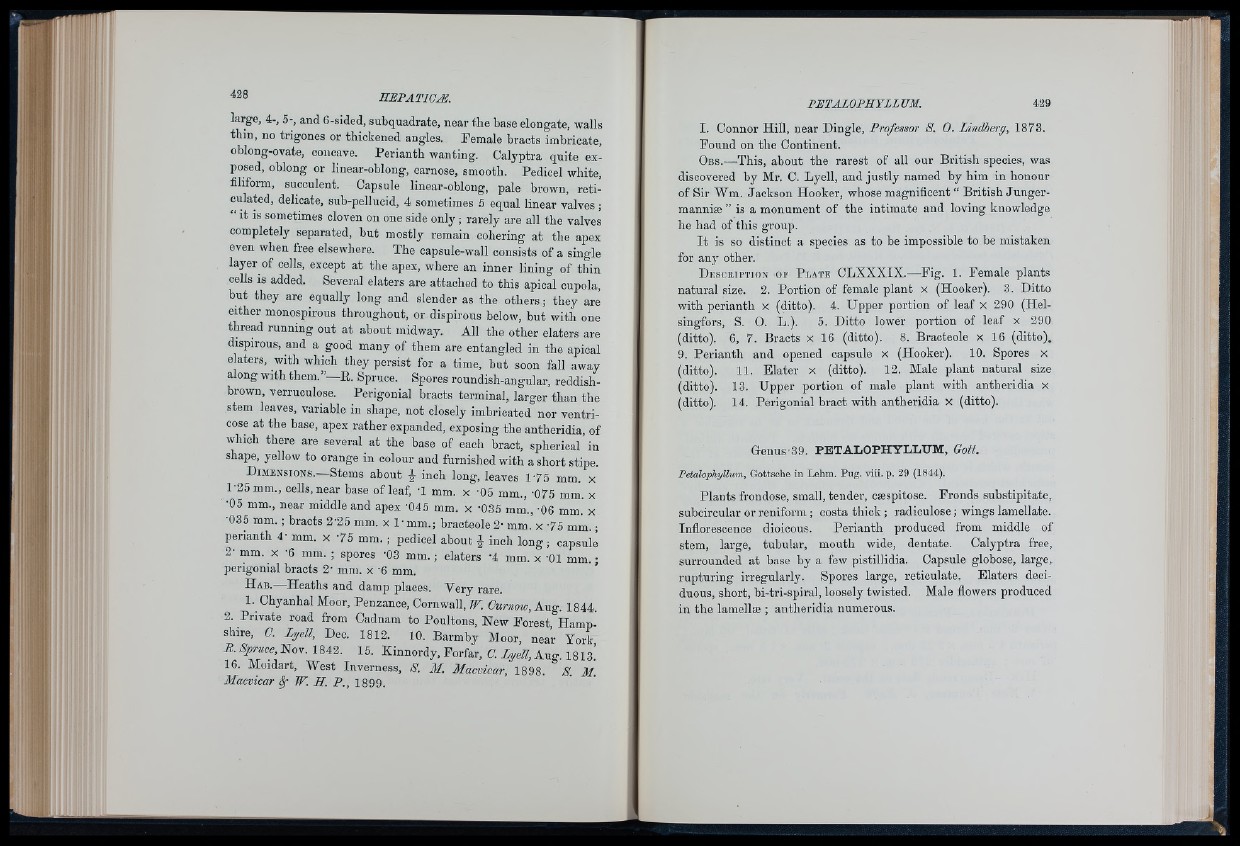
large, 4-, 5-, and 6-sided, suhquadrate, near the base elongate, walls
thin, no trigones or thickened angles. Female bracts imbricate,
oblong-ovate, concave. Perianth wanting. Calyptra quite exposed,
oblong or linear-oblong, carnose, smooth. Pedicel white,
filiform, succulent. Capsule linear-oblong, pale brown, reticulated,
delicate, sub-pellucid, 4 sometimes 5 equal linear valves ;
“ it IS sometimes cloven on one side only ; rarely are all the valves
completely separated, but mostly remain cohering at the apex
even when free elsewhere. The capsule-wall consists of a single
layer of cells, except at the apex, where an inner lining of thin
cells is added. Several elaters are attached to this apical cupola,
but they are equally long and slender as the others ; they are
either monospirous throughout, or dispirous below, but with one
thread running out at about midway. All the other elaters are
dispirous, and a good many of them are entangled in the apical
elaters, with which they persist for a time, but soon fall away
along with them.”—E. Spruce. Spores roundish-angular, reddish-
brown, verruculose. Perigonial bracts terminal, larger than the
stem leaves, variable in shape, not closely imbricated nor ventricose
at the base, apex rather expanded, exposing the antheridia, of
which there are several at the base of each braot, spherical’ in
shape, yellow to orange in colour and furnished with a short stipe.
D im e n s io n s .— Stems about j- inch long, leaves 175 mm. x
1-25 mm., cells, near base of leaf, T mm. x '05 mm., '075 mm. x
•05 mm., near middle and apex -045 mm. x -035 mm., -06 mm’ x
•035 mm. ; bracts 2-25 mm. x Fmm.; bracteole2- mm. x -75 mm •
perianth 4' mm. x -75 mm. ; pedicel about | inch long ; capsuk
2 mm. x -6 mm. ; spores •OS mm.; elaters A mm. x -01 mm.;
perigonial bracts 2- mni. x -6 mm.
H ab.—H eaths and damp places. Very rare.
1. Chyanhal Moor, Penzance, Cornwall, TF. Curmw, Aug. 1844.
2. Private road from Cadnam to Poultons, New Forest, Hamp-'
shire, C. Igqell, Dec. 1812. 10. Barmby Moor, near York
H. Spruce, Nov. 1842. 15. Kinnordy, Porfar, C. Lyell, Aug. 1813.’
16. Moidart, West Inverness, A. M. Macvicar, 1898. S. M.
Macvicar fl TF. H. P., 1899.
I. Connor Hill, near Dingle, Professor S. 0. Lindberg, 1873.
Pound on the Continent.
O b s .— This, about the rarest of all our British species, was
discovered by Mr. C. Lyell, and justly named by him in honour
of Sir Wm. Jackson Hooker, whose magnificent “ British Junger-
manniai ” is a monument of the intimate and loving knowledge
he had of this group.
I t is so distinct a species as to be impossible to he mistaken
for any other.
D e s c r ip t io n oe P la t e CLXXXIX.—Fig. 1. Female plants
natural size. 2. Portion of female plant x (Hooker). 3. Ditto
with perianth x (ditto). 4. Upper portion of leaf x 290 (Helsingfors,
S. 0 . L.). 5. Ditto lower portion of leaf x 290
(ditto). 6, 7. Bracts x 16 (ditto). 8. Bracteole x 16 (ditto).
9. Perianth and opened capsule x (Hooker). 10. Spores x
(ditto). 11. Elater x (ditto). 12. Male plant natural size
(ditto). 13. Upper portion of male plant with antheridia x
(ditto). 14. Perigonial bract with antheridia x (ditto).
Cenus 39. PETALOPHYLLXIM, Gott.
Petalophylhim, Gottsche in Lehm. Pug. viii. p. 29 (1844).
Plants frondose, small, tender, cæspitose. Fronds substipitate,
subcircular or reniform ; costa thick ; radiculose ; wings lamellate.
Inflorescence dioicous. Perianth produced from middle of
stem, large, tubular, mouth wide, dentate. Calyptra free,
surrounded at base hy a few pistillidia. Capsule globose, large,
rupturing irregularly. Spores large, reticulate. Elaters deciduous,
short, bi-tri-spiral, loosely twisted. Male flowers produced
in the lamellæ ; antheridia numerous.